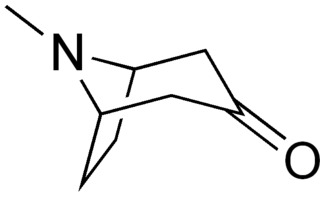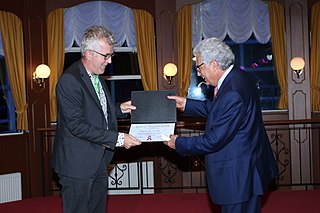Related Research Articles
Products are the species formed from chemical reactions. During a chemical reaction, reactants are transformed into products after passing through a high energy transition state. This process results in the consumption of the reactants. It can be a spontaneous reaction or mediated by catalysts which lower the energy of the transition state, and by solvents which provide the chemical environment necessary for the reaction to take place. When represented in chemical equations, products are by convention drawn on the right-hand side, even in the case of reversible reactions. The properties of products such as their energies help determine several characteristics of a chemical reaction, such as whether the reaction is exergonic or endergonic. Additionally, the properties of a product can make it easier to extract and purify following a chemical reaction, especially if the product has a different state of matter than the reactants.

Tropinone is an alkaloid, famously synthesised in 1917 by Robert Robinson as a synthetic precursor to atropine, a scarce commodity during World War I. Tropinone and the alkaloids cocaine and atropine all share the same tropane core structure. Its corresponding conjugate acid at pH 7.3 major species is known as tropiniumone.

The Baeyer–Villiger oxidation is an organic reaction that forms an ester from a ketone or a lactone from a cyclic ketone, using peroxyacids or peroxides as the oxidant. The reaction is named after Adolf von Baeyer and Victor Villiger who first reported the reaction in 1899.

Biocatalysis refers to the use of living (biological) systems or their parts to speed up (catalyze) chemical reactions. In biocatalytic processes, natural catalysts, such as enzymes, perform chemical transformations on organic compounds. Both enzymes that have been more or less isolated and enzymes still residing inside living cells are employed for this task. Modern biotechnology, specifically directed evolution, has made the production of modified or non-natural enzymes possible. This has enabled the development of enzymes that can catalyze novel small molecule transformations that may be difficult or impossible using classical synthetic organic chemistry. Utilizing natural or modified enzymes to perform organic synthesis is termed chemoenzymatic synthesis; the reactions performed by the enzyme are classified as chemoenzymatic reactions.

Professor Rudolf Konrad Allemann is a Distinguished Research Professor and Pro Vice-Chancellor International and Student Recruitment and Head of the College of Physical Sciences and Engineering at Cardiff University. Allemann joined Cardiff University in 2005, after working at the University of Birmingham, the Swiss Federal Institute of Technology ETH Zurich and the UK MRC National Institute for Medical Research at Mill Hill. He was previously Head of the School of Chemistry at Cardiff University until April 2017.
Biomimetic synthesis is an area of organic chemical synthesis that is specifically biologically inspired. The term encompasses both the testing of a "biogenetic hypothesis" through execution of a series of reactions designed to parallel the proposed biosynthesis, as well as programs of study where a synthetic reaction or reactions aimed at a desired synthetic goal are designed to mimic one or more known enzymic transformations of an established biosynthetic pathway. The earliest generally cited example of a biomimetic synthesis is Sir Robert Robinson's organic synthesis of the alkaloid tropinone.
Bioretrosynthesis is a technique for synthesizing organic chemicals from inexpensive precursors and evolved enzymes. The technique builds on the retro-evolution hypothesis proposed in 1945 by geneticist Norman Horowitz.

Gideon John Davies is a Professor of Chemistry in the Structural Biology Laboratory (YSBL) at the University of York, UK. Davies is best known for his ground-breaking studies into carbohydrate-active enzymes, notably analysing the conformational and mechanistic basis for catalysis and applying this for societal benefit. In 2016 Davies was apppointed the Royal Society Ken Murray Research Professor at the University of York.

Benjamin Guy Davis is Professor of Chemical biology in the Department of Pharmacology and a member of the Faculty in the Department of Chemistry at the University of Oxford and a Fellow of Pembroke College, Oxford. He holds the role of Science Director for Next Generation Chemistry (2019-2024) at the Rosalind Franklin Institute.

Nigel Shaun Scrutton is a British biochemist and biotechnology innovator known for his work on enzyme catalysis, biophysics and synthetic biology. He is Director of the UK Future Biomanufacturing Research Hub, Director of the Fine and Speciality Chemicals Synthetic Biology Research Centre (SYNBIOCHEM), and Co-founder, Director and Chief Scientific Officer of the 'fuels-from-biology' company C3 Biotechnologies Ltd. He is Professor of Enzymology and Biophysical Chemistry in the Department of Chemistry at the University of Manchester. He is former Director of the Manchester Institute of Biotechnology (MIB).
Morphinone reductase is an enzyme which catalyzes the NADH-dependent saturation of the carbon-carbon double bond of morphinone and codeinone, yielding hydromorphone and hydrocodone respectively. This saturation reaction is assisted by a FMN cofactor and the enzyme is a member of the α/β-barrel flavoprotein family. The sequence of the enzyme has been obtained from bacteria Pseudomonas putida M10 and has been successfully expressed in yeast and other bacterial species. The enzyme is reported to harbor high sequence and structural similarity to the Old Yellow Enzyme, a large group of flavin-dependent redox biocatalysts of yeast species, and an oestrogen-binding protein of Candida albicans. The enzyme has demonstrated value in biosynthesis of semi-opiate drugs in microorganisms, expanding the chemical diversity of BIA biosynthesis.

Marco Wilhelmus Fraaije is a Dutch scientist whose research concerns enzymology of redox enzymes, enzyme discovery & engineering and biocatalysis at the Groningen Biomolecular Sciences and Biotechnology Institute (GBB) at the University of Groningen.
Alison Rae Hardin Narayan is an American chemist and the William R. Roush assistant professor in the Department of Chemistry at the University of Michigan College of Literature, Science, and the Arts. Additionally, she is a research assistant professor at University of Michigan Life Sciences Institute.
Sabine Flitsch is a German organic chemist and chemical biologist who holds a personal chair in Chemical Biology at the University of Manchester School of Chemistry, where she runs an active research glycobiology research group based in the Manchester Interdisciplinary Biocentre.

Cyclophellitol is a potent irreversible inhibitor of beta-glucosidases. It is a cyclitol mimic of beta-glucose with an epoxide group in place of the acetal group found in glucosides. When recognized, cyclophellitol undergoes an acid-catalyzed ring-opening addition reaction with the catalytic nucleophile of a retaining glycoside hydrolase. The resulting ester linkage cannot be hydrolyzed by the normal catalytic machinery of the enzyme, resulting in irreversible inhibition.
Matthew John Fuchter is a British chemist who is a Professor of Chemistry at Imperial College London. His research focuses on the development and application of novel functional molecular systems to a broad range of areas; from materials to medicine. He has been awarded both the Harrison-Meldola Memorial Prize (2014) and the Corday–Morgan Prizes (2021) of the Royal Society of Chemistry. In 2020 he was a finalist for the Blavatnik Awards for Young Scientists.

Lu Shin Wong is a Senior Lecturer in the Department of Chemistry at The University of Manchester. His research in general is based on industrial biotechnology and materials chemistry, specifically on nanofabrication and biocatalysis.
Tracey Maureen Gloster is a chemist at the University of St Andrews UK. Her research interests are in structural biology, chemical biology, glycobiology and carbohydrate processing enzymes.
Yi Tang is a biochemist and professor in the Department of Chemistry and Biochemistry and the Department of Chemical and Biomolecular Engineering at the University of California, Los Angeles. His research interests include the discovery, functional characterization, and engineering of natural product biosynthetic enzymes. He was awarded the 2014 Eli Lilly Award in Biological Chemistry.

Jason Micklefield is a British Biochemist and a professor in the Department of Chemistry at The University of Manchester. His research involves the discovery, characterisation and engineering of biosynthetic pathways to new bioactive natural products, particularly antibiotics. He is also interested in the discovery, structure, mechanism and engineering of enzymes for synthetic applications, including the integration of enzymes with chemocatalysis for telescoping routes to pharmaceuticals and other valuable products.
References
- ↑ "Prof. Nicholas Turner (CV)" (PDF). Retrieved 18 June 2020.
- 1 2 3 4 5 Turner Lab. "Prof. Nicholas Turner" . Retrieved 18 June 2020.
- 1 2 Royal Society of Chemistry. "Dextra Carbohydrate Chemistry Award" . Retrieved 18 June 2020.
- 1 2 Royal Society of Chemistry. "Corday-Morgan Prize Previous Winners" . Retrieved 18 June 2020.
- 1 2 Royal Society of Chemistry. "Organic Industrial Chemistry Award 2009 winner" . Retrieved 18 June 2020.
- 1 2 Royal Society of Chemistry. "Organic Stereochemistry Award 2017 Winner" . Retrieved 18 June 2020.
- 1 2 American Chemical Society. "Congratulations to the 2018 ACS Catalysis Lectureship Recipient: Professor Nicholas Turner" . Retrieved 18 June 2020.
- 1 2 3 4 Royal Society. "Royal Society Fellows" . Retrieved 18 June 2020.
- 1 2 "Prof. Nicholas J. Turner: Publications" . Retrieved 18 June 2020.
- 1 2 "Prof. Nicholas J. Turner: Publications" . Retrieved 16 June 2020.
- 1 2 Nicholas J., Turner (1985). Mechanistic studies on isopenicillin N synthase (PhD thesis).(subscription required)
- 1 2 University of Manchester NMR Group. "Prof. Nicholas Turner" . Retrieved 18 June 2020.
- ↑ CoEBio3. "CoEBio3 Activities" . Retrieved 18 June 2020.
- ↑ Ingenza. "Ingenza(Management)" . Retrieved 18 June 2020.
- ↑ (Synbiochem) Manchester Synthetic Biology Research Center. "Synbiochem" . Retrieved 18 June 2020.
- ↑ Turner, Nicholas; Turner, Michael K.; Roberts, Stanley M.; Willetts, Andrew J. (27 January 1995). Willetts, Andrew J. (ed.). Introduction to Biocatalysis Using Enzymes and Microorganisms. Cambridge: Cambridge University Press. doi:10.1017/CBO9780511752254. ISBN 9780511752254.
- 1 2 Turner, Nicholas; Humphreys, Luke (8 February 2018). Biocatalysis in Organic Synthesis: The Retrosynthesis Approach. United Kingdom: Royal Society of Chemistry. ISBN 978-1-78801-342-0.
- ↑ Turner, Nicholas (23 April 2012). "Oxidation of C - N Bonds". In Drauz, Karlheinz; Gröger, Harald; May, Oliver (eds.). Biocatalysis in Organic Synthesis: The Retrosynthesis Approach. United Kingdom: Wiley‐VCH Verlag GmbH & Co. KGaA. pp. 1535–1552. doi:10.1002/9783527639861. ISBN 9783527325474.
- ↑ Turner, Nicholas; O’Reilly, Elaine (2013). "Biocatalytic retrosynthesis" (PDF). Nature Chemical Biology. 9 (5): 285–288. doi:10.1038/nchembio.1235. PMID 23594772 . Retrieved 18 June 2020.
- ↑ Turner, Nicholas (2009). "Directed evolution drives the next generation of biocatalysts". Nature Chemical Biology. 5 (8): 567–573. doi:10.1038/nchembio.203. PMID 19620998 . Retrieved 18 June 2020.
- ↑ Turner, Nicholas; Jones, Patrik R.; Akhtar, M. Kalim (2012). "Carboxylic acid reductase is a versatile enzyme for the conversion of fatty acids into fuels and chemical commodities". PNAS. 110 (1): 87–92. doi: 10.1073/pnas.1216516110 . PMC 3538209 . PMID 23248280.
- ↑ Turner, N.; Köhler, V.; Wilson, V.M.; Dürrenberger, M.; Ghislieri, D.; Churakova, E.; Quinto, T; Knörr, L.; Häussinger, D.; Hollmann, F.; Ward, T.R. (2013). "Synthetic cascades are enabled by combining biocatalysts with artificial metalloenzymes". Nature Chemistry. 5 (2): 93–99. doi:10.1038/nchem.1498. PMID 23344429. S2CID 205290846 . Retrieved 18 June 2020.